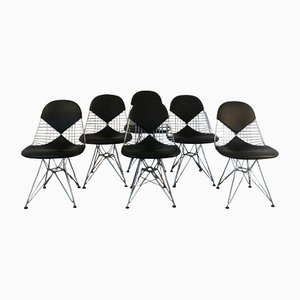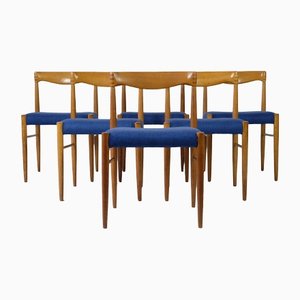Traducción generada automáticamente
Mostrar original
Mostrar traducción
Set of four dining chairs with a frame in black lacquered metal and seat in curved plywood, attributed to Carlo Ratti and produced by Società Compensati Curvati in the 1950s.
In Italy, at the beginning of the XX century, industries of curved solid wood arose under license of Michael Thonet, and through the International Exhibitions the processing of curved wood became more and more widespread.
The Expo of the first decade was also attended by the wood manufacturers of Monza, while in 1905 Otto Helzer, in Switzerland, patented wooden structures in curved laminated, whose strength was equivalent to those in steel.
The Ratti brothers of Monza took their cue from the solid wood laminate to create furniture that, instead of wooden elements, used sheets of wood.
The brothers Ratti, Carlo and Mario, also began to follow the young artistic avant-gardes (cubism, futurism and abstractionism).
The mastery of wooden sculpture influenced Carlo in the design and realization of furniture of fine neo-plastic artistic workmanship and decò, receiving honors from the Prince of Piedmont Umberto di Savoia.
In 1919, in Milan, the first Lombard Exhibition of Decorative Arts was set up (later to become the Triennale) and the Ratti brothers exhibited their furniture in solid wood but also in curved panel with a new system of curvature, the one in Telo.
The canvas system was developed by the Ratti brothers with the help of a friend, Cesare Cantù.
They developed an elastomer bag in which the mould was inserted with the panel to be bent and, closing it with clamps, the air inside was removed, thus making the panel adhere to the mould.
Carlo and Mario found in the Telo system a means by which they could make objects and furniture in the three spatial directions with large surface curvatures, without limits of thickness and minimum radii of curvature.
In 1921 in Stuttgart the first Salone del Mobile was inaugurated and the Fratelli Ratti of Monza made itself known internationally by presenting solid wood furniture and also furniture in load-bearing plywood, flanked by furniture with framed and interchangeable covers.
The Expo became meeting places to verify and present the novelties in the furniture and industrialization sector and, with the development of Industrial Design, the first architects joined in the design of the furniture industries.
The Ratti Brothers, in the various international and national exhibitions, also presented incredible objects in their realization with the system in Telo.
After 1930 Carlo and Mario produced many containers for radio and folding chairs for cinema but in 1939 they divided and in Monza Mario remained who, with his sons Antonio and Angela, formed the Società Compensati Curvi.
Carlo moved to Lissone, forming with his sons Angelo and Piera and with her husband, Piero Berruti, the Industria Legni Curvati. After the war, a new bending system, the Mould and Counter-mould, was added to the existing systems from the 1950s.
After the war, the architects devoted themselves exclusively to the planning and reconstruction of the territory and the need to regain the markets put the industrialists in conditions to offer quality products, designed by architects-designers of the new generation.
Both Carlo Ratti’s and Mario’s firm began collaborating with world-famous architects such as Ignazio Gardella, Paolo Chessa, Vico Magistretti, the Castiglioni brothers, Vittoriano Vigano, Marco Zanuso, Carlo de Carli, etc.
In those years many technological objects were made with curved plywood bodies such as washing machines, televisions, radios, sewing machines, etc. while the production of furniture in a rationalistic style continued.
The new bending technologies, Mould and Counter-mould and High Frequency, allowed a remarkable mass production and, if the old system in Telo continued to exist to make extraordinary objects with Coons curves, especially the High Frequency spread all over the world.
The Japanese company Tendo Mokko invented this new bending system in 1948, trying to make plywood planes and, immediately, the company Ratti of Monza used it, while that of Lissone continued to make products with the old Mould and Counter-mould system.
This system used aluminum shapes unlike other systems that, instead, made wooden shapes, with considerable economic savings.
In 1954 a chair designed by Carlo de Carli for Cassina and made by Carlo Ratti won the "Compasso d'Oro" award as an object of considerable technical and aesthetic value.
In 1961 Carlo Ratti died and his sons Angelo and Piera, with her husband Piero Berruti, continued the activity while the third generation was entering the company.
The company transformed from Industria Legni Curvati into Carlo Ratti s.a.s and, since then, new collaborations with young architects allowed a new technological development.
Thus, the High Frequency system was introduced in the company, but the Mould and Counter-mould system was not abandoned and, above all, the Telo system that was still used for the production of samples and prototypes.
Juego de cuatro sillas de comedor con armazón de metal lacado en negro y asiento de contrachapado curvado, atribuidas a Carlo Ratti y producidas por Società Compensati Curvati en la década de 1950.
En Italia, a principios del siglo XX, surgieron industrias de madera maciza curvada bajo licencia de Michael Thonet, y a través de las Exposiciones Internacionales se difundió cada vez más el tratamiento de la madera curvada.
A la Expo de la primera década acudieron también los fabricantes de madera de Monza, mientras que en 1905 Otto Helzer, en Suiza, patentaba estructuras de madera en laminado curvado, cuya resistencia era equivalente a las de acero.
Los hermanos Ratti, de Monza, tomaron ejemplo del laminado de madera maciza para crear muebles que, en lugar de elementos de madera, utilizaban láminas de madera.
Los hermanos Ratti, Carlo y Mario, también empezaron a seguir las jóvenes vanguardias artísticas (cubismo, futurismo y abstraccionismo).
El dominio de la escultura en madera influyó en Carlo en el diseño y realización de muebles de fina factura artística neoplástica y decò, recibiendo honores del príncipe de Piamonte Umberto di Savoia.
En 1919 se celebró en Milán la primera Exposición Lombarda de Artes Decorativas (que más tarde se convertiría en la Triennale) y los hermanos Ratti expusieron sus muebles de madera maciza pero también de panel curvado con un nuevo sistema de curvatura, el de Telo.
El sistema de lona fue desarrollado por los hermanos Ratti con la ayuda de un amigo, Cesare Cantù.
Desarrollaron una bolsa de elastómero en la que se introducía el molde con el panel a curvar y, cerrándola con pinzas, se extraía el aire del interior, con lo que el panel quedaba adherido al molde.
Carlo y Mario encontraron en el sistema Telo un medio que les permitía fabricar objetos y muebles en las tres direcciones espaciales con grandes curvaturas superficiales, sin límites de grosor ni radios mínimos de curvatura.
En 1921 se inauguró en Stuttgart el primer Salone del Mobile y los Fratelli Ratti de Monza se dieron a conocer internacionalmente presentando muebles de madera maciza y también muebles de contrachapado portante, flanqueados por muebles con tapas enmarcadas e intercambiables.
Las Expo se convirtieron en lugares de encuentro para verificar y presentar las novedades en el sector del mueble y de la industrialización y, con el desarrollo del Diseño Industrial, los primeros arquitectos se incorporaron al diseño de las industrias del mueble.
Los hermanos Ratti, en las diversas exposiciones internacionales y nacionales, también presentaron objetos increíbles en su realización con el sistema en Telo.
Después de 1930 Carlo y Mario produjeron muchos contenedores para la radio y sillas plegables para el cine, pero en 1939 se dividieron y en Monza se quedó Mario que, con sus hijos Antonio y Angela, formó la Società Compensati Curvi.
Carlo se trasladó a Lissone, formando con sus hijos Angelo y Piera y con su marido, Piero Berruti, la Industria Legni Curvati. Después de la guerra, un nuevo sistema de curvado, el Molde y Contramolde, se añadió a los sistemas existentes desde los años cincuenta.
Tras la guerra, los arquitectos se dedicaron exclusivamente a la planificación y reconstrucción del territorio y la necesidad de recuperar los mercados puso a los industriales en condiciones de ofrecer productos de calidad, diseñados por arquitectos-diseñadores de la nueva generación.
Tanto la empresa de Carlo Ratti como la de Mario empezaron a colaborar con arquitectos de fama mundial como Ignazio Gardella, Paolo Chessa, Vico Magistretti, los hermanos Castiglioni, Vittoriano Vigano, Marco Zanuso, Carlo de Carli, etc.
En aquellos años se fabricaron muchos objetos tecnológicos con cuerpos curvados de madera contrachapada, como lavadoras, televisores, radios, máquinas de coser, etc., mientras continuaba la producción de muebles de estilo racionalista.
Las nuevas tecnologías de curvado, Molde y Contramolde y Alta Frecuencia, permitieron una notable producción en serie y, si el antiguo sistema de Telo siguió existiendo para realizar extraordinarios objetos con curvas Coons, especialmente la Alta Frecuencia se extendió por todo el mundo.
La empresa japonesa Tendo Mokko inventó este nuevo sistema de curvado en 1948, tratando de fabricar planos de madera contrachapada e, inmediatamente, la empresa Ratti de Monza lo utilizó, mientras que la de Lissone siguió fabricando productos con el antiguo sistema de Molde y Contramolde.
Este sistema utilizaba formas de aluminio a diferencia de otros sistemas que, en cambio, hacían formas de madera, con un considerable ahorro económico.
En 1954, una silla diseñada por Carlo de Carli para Cassina y fabricada por Carlo Ratti ganó el premio "Compasso d'Oro" como objeto de considerable valor técnico y estético.
En 1961 falleció Carlo Ratti y sus hijos Angelo y Piera, con su marido Piero Berruti, continuaron la actividad mientras la tercera generación entraba en la empresa.
La empresa se transformó de Industria Legni Curvati en Carlo Ratti s.a.s y, desde entonces, nuevas colaboraciones con jóvenes arquitectos permitieron un nuevo desarrollo tecnológico.
Así, se introdujo en la empresa el sistema de Alta Frecuencia, pero no se abandonó el sistema de Molde y Contramolde y, sobre todo, el sistema Telo que se siguió utilizando para la producción de muestras y prototipos.




Contacta con nosotros
Haz una oferta
¡Hemos notado que eres nuevo en Pamono!
Por favor, acepta los Términos y condiciones y nuestra Política de privacidad
Contacta con nosotros
Haz una oferta
¡Ya casi está!
Para seguir la conversación en la plataforma, por favor completa el registro. Para proceder con tu oferta en la plataforma, por favor completa el registro.Exitoso
Gracias por tu consulta, alguien de nuestro equipo se pondrá en contacto contigo en breve.
Si eres profesional del diseño, por favor solicita aquí los beneficios del Programa comercial de Pamono